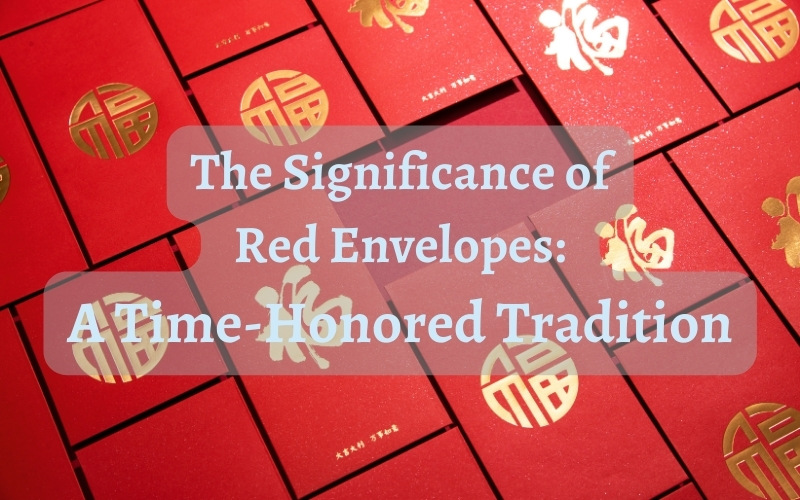Unwrapping The Tradition: The Fascinating World Of Red Envelopes
There's something magical about opening a red envelope during special occasions. It’s not just a piece of paper or money inside—it carries centuries of tradition, meaning, and goodwill. Red envelopes, or "hongbao" as they’re often called in Chinese culture, are more than gifts; they're symbols of prosperity, protection, and love. Whether you're celebrating Lunar New Year, a wedding, or even a birthday, these vibrant crimson pouches hold stories that connect generations.
So why do people give red envelopes? Why is red so important? And what makes this practice so fascinating across cultures? Let’s dive into the heart of this age-old tradition and uncover its secrets. Stick around because we’re about to unwrap a whole lot more than just cash here!
By the end of this article, you’ll have a deeper understanding of the history, significance, and modern relevance of red envelopes. Plus, you might even pick up some tips for giving them yourself. Who knows—maybe next time you hand one over, you’ll feel like you're carrying on a legacy thousands of years in the making.
Read also:Exploring Free Remote Access Solutions For Iot Devices
What Are Red Envelopes Anyway?
Let’s break it down. Red envelopes are essentially rectangular pouches made from red paper, often decorated with gold foil patterns, lucky characters, or zodiac symbols. They’re used to carry money as a gift during significant events such as weddings, festivals, and birthdays. But don’t let their simplicity fool you—there’s a whole world of meaning behind them.
Red envelopes are deeply tied to Asian traditions, particularly in China, where they symbolize good fortune and ward off evil spirits. The color red itself is considered auspicious, representing joy, vitality, and prosperity. Historically, red envelopes were given to children during Lunar New Year to protect them from bad luck and ensure a prosperous year ahead.
Why Red?
Ever wondered why red is the go-to color for these envelopes? Well, it all comes down to its cultural significance. In Chinese mythology, red is believed to repel demons and bring positive energy. Legend has it that long ago, a village was plagued by a fearsome beast called Nian, which would attack villagers every year. To scare it away, the villagers lit red lanterns, hung red banners, and set off fireworks—all in the color red. This story became the foundation for using red in celebrations, including the tradition of red envelopes.
History Behind the Red Envelope Tradition
The roots of red envelopes can be traced back thousands of years to ancient China. During the Han Dynasty (206 BC – 220 AD), elders would give coins strung together with red strings to younger generations during New Year celebrations. These coins were thought to protect children from sickness and misfortune. Over time, the practice evolved into the modern-day red envelope we know today.
In the Tang Dynasty (618–907 AD), emperors began distributing red packets filled with money to their subjects as a gesture of goodwill. This act solidified the red envelope as a symbol of generosity and respect. As trade and migration spread across Asia, the tradition took hold in other countries like Vietnam, Korea, and Singapore, each adding its own unique twist.
Evolution Over Time
Fast forward to the present day, and red envelopes have gone digital. With apps like WeChat and Alipay, people can now send virtual hongbaos with just a few taps on their phones. This shift reflects how technology has adapted traditional customs to fit modern lifestyles. Despite this change, the essence of the red envelope remains the same: spreading happiness and sharing blessings.
Read also:Chinese New Year 1985 Animal A Year Of The Ox And What It Means
Symbolism of Red Envelopes
Red envelopes aren’t just about the money inside—they carry layers of meaning. Each element, from the color to the design, holds significance. For instance, the number eight (8) is highly favored because it sounds similar to the word for "prosperity" in Mandarin. That’s why you’ll often see amounts like $8, $88, or $188 in red envelopes.
Gold accents on the envelopes also play a role. Gold represents wealth and success, making it the perfect complement to the red exterior. Some envelopes feature specific phrases or characters, such as "fu" (good fortune) or "xi" (happiness), further emphasizing the positive intentions behind the gift.
Unwritten Rules of Giving Red Envelopes
When it comes to giving red envelopes, there are certain unwritten rules to follow. First, the amount should always be an even number, as odd numbers are associated with funerals. Second, avoid giving amounts with the number four (4), which sounds like "death" in many East Asian languages. Lastly, the money should be crisp and new, as handing over wrinkled bills might come across as disrespectful.
Red Envelopes in Different Cultures
While red envelopes are most commonly associated with Chinese culture, variations of the tradition exist in other parts of Asia. In Vietnam, for example, red envelopes are called "li xi" and are typically given during Tet, the Vietnamese Lunar New Year. Similarly, in Korea, white envelopes with red and blue borders, known as "pae-bae," are used for weddings and other formal occasions.
Even outside Asia, the concept of gifting money in decorative envelopes has gained popularity. In Western countries, people sometimes use festive or themed envelopes for birthdays, graduations, or holidays. While the designs may differ, the sentiment of generosity and goodwill remains universal.
Global Adaptations
One interesting adaptation is the rise of digital red envelopes. Platforms like GrabPay in Southeast Asia and PayPal in the West allow users to send money instantly via mobile apps. This convenience has made it easier for people to participate in the tradition, regardless of geographical distance.
How to Give Red Envelopes Like a Pro
Now that you know the history and significance, let’s talk practical tips. If you’re planning to give red envelopes, here’s how to do it right:
- Choose high-quality envelopes with meaningful designs.
- Include crisp, new bills in appropriate denominations.
- Present the envelope with both hands as a sign of respect.
- Refrain from opening the envelope in front of the giver—it’s considered rude.
- Consider the occasion and recipient when deciding the amount.
Remember, the gesture itself is just as important as the contents. A thoughtfully chosen red envelope can leave a lasting impression.
Modern Trends in Red Envelopes
As times change, so does the way we celebrate traditions. Today, red envelopes come in all shapes and sizes, from eco-friendly biodegradable options to personalized designs featuring family photos or custom messages. Some companies even offer branded envelopes as marketing tools during holiday seasons.
Digital red envelopes have also introduced new ways of engagement. For instance, during Lunar New Year, users participate in virtual "grabbing" games where they compete to collect the most hongbaos. This blend of tradition and innovation keeps the practice fresh and exciting for younger generations.
Environmental Concerns
With growing awareness about sustainability, many people are turning to eco-friendly alternatives. Biodegradable or reusable envelopes made from recycled materials are becoming increasingly popular. Additionally, digital options help reduce waste by eliminating the need for physical envelopes altogether.
Red Envelopes and Financial Etiquette
While red envelopes are primarily a cultural tradition, they also involve financial considerations. Knowing how much to give can be tricky, especially if you're unfamiliar with local customs. As a general guideline, amounts vary depending on the occasion:
- Weddings: Typically higher amounts, often equivalent to the cost of the meal per guest.
- Birthday: Smaller amounts, usually based on your relationship with the recipient.
- New Year: Varies widely, but smaller denominations are acceptable for children.
It’s always a good idea to ask friends or family members familiar with the culture for advice. After all, showing respect through proper etiquette is key to maintaining relationships.
Red Envelopes in Popular Media
Red envelopes have made appearances in movies, TV shows, and literature, often highlighting their emotional significance. In the film "Crazy Rich Asians," for example, red envelopes are exchanged at a lavish wedding, symbolizing the blending of cultures and traditions. Similarly, in novels like "The Joy Luck Club," red envelopes serve as a bridge between generations, connecting parents and children through shared values.
These portrayals underscore the enduring appeal of red envelopes as both a cultural artifact and a universal symbol of generosity.
Celebrity Endorsements
Several celebrities have embraced the red envelope tradition, using it to connect with fans during special events. For instance, during Chinese New Year, many Asian stars share photos of themselves handing out hongbaos, creating a sense of intimacy and gratitude. Such gestures reinforce the idea that red envelopes transcend borders and unite people through shared experiences.
Conclusion: Wrapping Up the Red Envelope Tradition
We’ve journeyed through the rich history, symbolism, and modern adaptations of red envelopes, uncovering the depth of this timeless tradition. From their origins in ancient China to their global reach today, red envelopes continue to play a vital role in bringing people together.
So the next time you find yourself holding a red envelope, take a moment to appreciate the stories it carries. Whether you’re giving or receiving one, remember that it’s more than just a gift—it’s a connection to something much bigger.
Don’t forget to leave a comment below sharing your favorite red envelope memory! And if you enjoyed this article, feel free to share it with friends and family. After all, spreading knowledge is another way of giving back.
Table of Contents
- What Are Red Envelopes Anyway?
- History Behind the Red Envelope Tradition
- Symbolism of Red Envelopes
- Red Envelopes in Different Cultures
- How to Give Red Envelopes Like a Pro
- Modern Trends in Red Envelopes
- Red Envelopes and Financial Etiquette
- Red Envelopes in Popular Media
- Conclusion


